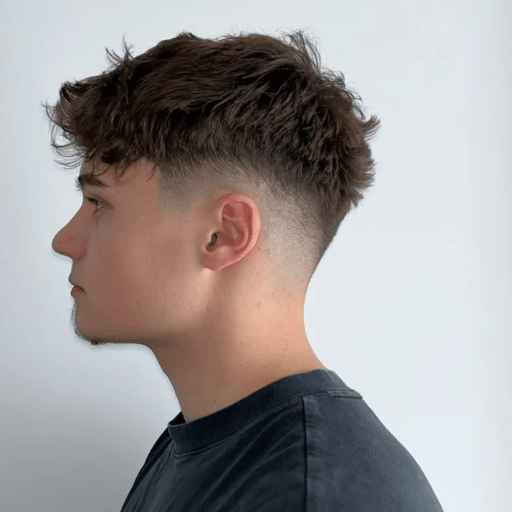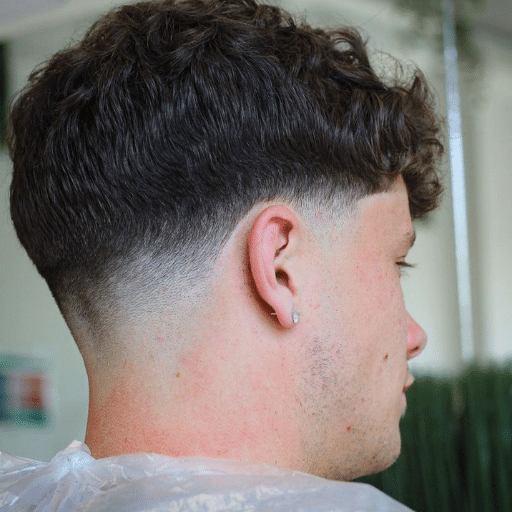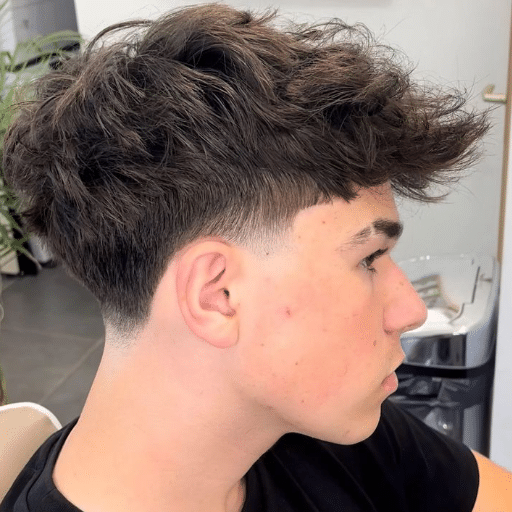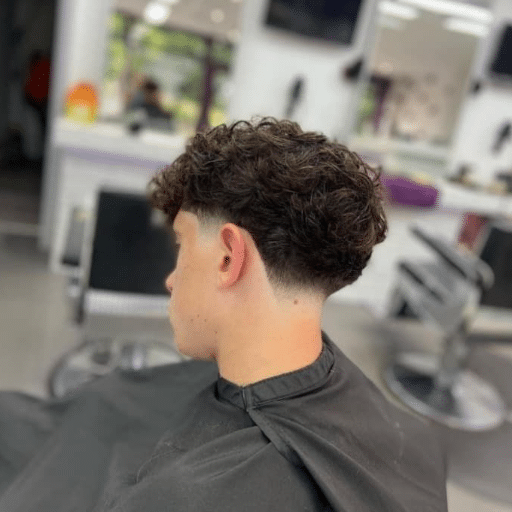The mid taper fade is a classic and modern haircut that will never go out of style for anyone who wants to look sharp while retaining a versatile appearance. In this guide, we will provide features and an overview of the mid taper fade, including its characteristics, how to style it in steps, and the tools needed to achieve a professional finish. Furthermore, we will highlight how to customize the haircut relative to different face and hair types, ensuring it can be tailored to anyone’s beauty aspirations. This article will help you to master the mid taper fade, whether you’re a styler refining your skills or an individual seeking advanced grooming options.
What is a Mid Taper Fade?

A Mid Taper Fade is a modern and multifunctional haircut featuring a decrease in hair length from the middle of the sides and back, blending into shorter lengths closer to the hairline. This style enhances one’s appearance by providing a polished look without creating any harsh lines, which is perfect for both work and leisure. It is also easy to mix and match different hair top styles like quiffs, slicked back styles, or textured crops, which means it is adaptable to different preferences and face shapes. Because it is positioned halfway between the low and high taper fade, it is one of the most flattering and versatile haircuts.
Understanding the Fade Technique
A fade is a specific type of blending in haircutting that requires precision and skill. This involves blending the longer and shorter lengths of hair smoothly without leaving any sharp, noticeable transitions. Fading requires an appropriate tool, like clippers with guards, as well as attention to detail; otherwise, sharp lines could appear. Fades come in different types: low, mid, and high fade, which are customizable based on the client’s hair texture, preferences, and facial structure. This technique’s versatility and the clean aesthetic add to its modern and classic widespread contour popularity.
How a Taper Differs from Other Styles
A taper stands out from other styles because it is more gradual and subtle. With tapers, unlike fades that usually take hair away completely at the lowest point, there is more length left and a less noticeable transition from longer to shorter hair. As a result, it is softer and more natural than the dramatic look of a fade. Furthermore, taper concentrates more on the sideburns and neckline instead of the whole head, which gives it elegance and refinement while being discreet. A taper works with different lengths and textures of hair, providing distinction while still retaining a neat and professional appearance.
The Evolution of the Taper Fade Haircut
Throughout the years, the taper fade haircut has greatly evolved due to its styling versatility and contemporary adaptations. Originally, this hairstyle called for sleek accuracy and a neat, military-inspired sharpness. Clean, disciplined looks were easy to achieve with the taper fade. Over time, however, fashion evolution incorporated personal choice and cultural diversity, contributing to the remodeling of the taper fade. The fusion of old school barbering with modern styles offers endless possibilities for people to adjust the length, texture, and fade levels. This evolution speaks to the haircut’s appeal; it’s rooted in tradition while finding ways to modernize style requirements.
How to Achieve the Perfect Taper Fade Haircut

Every haircut must have precision, technique, and attention to detail to achieve an ideal taper fade, and so begins the taper fade. First, determine the fade length and gradient you want. It can be skin tight with the longest hair on top or there can be a gradual blend. To ensure accurate cutting, begin with clean, damp hair. For the sides and back, start with clippers that have supplied guards. Start from the lowest setting for the shortest section of the fade, then raise guard levels as you go up for a seamless blend. Use a detail trimmer for sharp outlines which can also be used to define the hairline and neckline. Blend all the remaining disparities for a smooth transition using scissors while checking for symmetry and consistency through the process. Lastly, style properly to enhance the texture and overall appearance.
Steps to a Mid Taper Fade Haircut
To start, I prep the hair by cleaning it and making sure it is slightly damp for my full control during the cut. I use clippers and begin at the base of the hairline, slightly below the neck, while setting the guard length to the right size. As I go, I blend with longer guard lengths higher up while switching gradually to longer guard lengths till I reach the top, blending carefully to ensure a fade is achieved. The outline of the hair and neck is sharpened using a detail trimmer, which ensures the edges are sharp and clear. Then the top part is blended to the side with scissors, making sure all lines blend. Symmetry and balance is checked and adjusted meticulously and styling is completed by putting enhancing defining products to define the fade.
Tools Every Barber Needs
Tools Every Barber Needs All barbers know that having the right tools is essential to performing any services needed. From the beginning to the end of each haircut, a barber should have the right tools ready for use at all times. From high-quality clippers to detail trimmers, barbers need to start of any haircut with the best tools available. Trimmers are perfect for outlining so detailed work is easy for any barber to perform.
As the beard and hair are being trimmed with precision equipment, it is easy for barbers to use straight and thinning shears to manage the bulk of hair on top of the head. Having an adjustable blade on trimmers makes them easy to work with, especially with increasing and lowering lengths to perfection. Blades with defined edges also make it easy to give a beard and a precise trim. Combs are easy to section the hair while also guiding a barber to provide seamless cuts.
Apart from the cutting tools, I use a cape to keep my clients tidy and comfortable. I also use neck strips and disinfectants to ensure a proper clean. For styling and adding volume, a high-quality blow dryer is key. To complete the look, pomades, gels, and finishers ensure that every look is polished and defined. Any professional barber starts off with these essentials.
Advice from Professional Barbers
In terms of advice, I always try to highlight the importance of foundational techniques along with a good investment on tools. Make sure to understand the basics of cutting, fading and styling, form the base of barbering. Equally important is the investment in hygiene tools like a good set of clean, ergonomic, sharp shears and reliable clippers all the way to basic hygiene and workspace cleanliness. Always disinfect the tools and ensure a clean space. Pay attention to important client conversations and understand preferences to elevate the customer experience. It is very likely that the clients will visit again based on your professional recommendations. Lastly, always keep an eye on learning and the competition to stay updated on trends and techniques.
What are the Different Variations of the Taper Fade?

The taper fade is a versatile haircut that can be adapted to suit one’s preference and style. It can be categorized into low, mid, and high taper fades. The low taper fade begins just above the ears and offers a subtle, polished look perfect for business environments. The mid taper fade looks more balanced since it is more versatile, because it begins on the sides at a median height, blending with the hair. The high taper fade, also known as high fade, starts at the temples, which is more suited for fashion-forward individuals because of the bold statement it offers. There are also some additions to the classic style, such as the skin fade, which tapers to the skin, or the drop fade, which curves along the natural head. Every additional style can be modified to better suit a person’s face shape, the texture of hair, and style.
Low Taper Fade vs. High Taper Fade
While discussing the differences between low taper fade and high taper fade, we can focus more on the placement and the overall effect it gives. The low taper fade starts around the ears and neckline, giving off a more discreet fade than fades which is professional or conservative in nature. In contrast, the high taper fade starts around the temples on the head, which is smoother. This gives an edgy, bold look which is very modern. Both styles are versatile and can be customized based on a person’s face, hair, and how noticeable they want to be after the cut.
Exploring the Skin Fade Option
A skin fade is one of the modern and clean haircuts that begins with a shaved base and gradually blends into longer hair on the top. It is versatile and gives a man an appealing appearance with a smooth and polished finish. It can be adapted for different professional or casual settings. This style works well with a variety of hair types and textures. As with any style, when determining if the skin fade is appropriate for a person, a few things need to be considered: how often it needs to be touched up, natural flow of hair growth patterns, and face-shaped customization. Working with an experienced barber achieves the most satisfying attention to style objectives while blending with the skin tone and facial features.
Choosing Between Curly Hair and Straight Styles
In comparison to the more textured curly hair, the straight styles appear simpler. For my personal needs and lifestyle, I consider a few major factors before making a decision. Of the two, curly hair seems to be the more complicated and demanding style in terms of day-to-day maintenance, such as hydration and breaking tangles. From my experience, straight hair could be easier to manage and take care of style-wise. Also, I consider how each texture goes with my face and personal style: Curly hair can be voluminous and adds movement, while straight hair looks sleek and polished. No matter which option I end up choosing, I always pay attention to the effort that is needed for upkeep and the visual impact that comes with it.
Why is the Mid Taper Fade a Popular Choice?

The mid taper fade is a well-liked option because it is flattering on everyone and incredibly versatile. This particular haircut maintains a clean and streamlined look with the hair on top being longer, gradually tapering down to the areas close to ears and neck. The style works with most hair types, shapes, and even personal styles from formal to casual. Coupled with needing low-maintenance care while sporting a modern appeal, the mid taper fade becomes a go-to option for those needing functionality and style balance.
Benefits of This Low-Maintenance Style
The blend of professionalism and versatility is beautifully balanced with the mid taper fade. Perfect for people on the go, the fade is easy to maintain and sustain over time. The style’s neat, sharp appearance is complemented by gradual transitions of hair length working seamlessly with diverse hair types and face shapes while maintaining a clean look and reducing barber visits. These features, combined with the timeless charm this look offers, ensure it works well for countless users, alongside boasting adaptability without sacrificing style, making it highly impactful.
Achieving a Polished Look with Ease
In achieving a refined look effortlessly, I pay attention to my face shape and hair texture, choosing a hairstyle that works with them, looks neat, and is low maintenance at the same time. I avoid looking unkempt during this time by keeping a neat, blended cut, which also calms the frizz as the hair grows out. I balance my grooming with looking polished, tailoring my style to everyday tasks. With this strategy, I only need a few minutes to achieve a modern look that I maintain throughout the day.
Adapting the Style for Different Hair Types
While considering how to adapt a style for different hair types, baldness brings its very own set of considerations. With fine hair, I tend to use layering methods for volume to ensure the style maintains its shape and doesn’t look flat. For coarser or thicker hair, I tend to use thinning and texturizing to create a more even, balanced, and thus, easier to manage appearance. The curly hair tends to be followed with special regard to the natural curls, and so I go with cuts that enhance its shape and reduce frizz. This careful approach allows any style to be designed around specific characteristics, and therefore have a refined, effortless appearance regardless of the hair type texture.
How to Maintain Your Mid Taper Fade Haircut

Keeping your mid-taper fade sharp requires touchups every 2 to 3 weeks with a professional. You can put about a taper fade with clippers, and with a good precision trimmer, you can maintain it yourself until your next appointment. Alongside the haircut, maintain daily care for hair using sulfate-free shampoo and conditioner tailored towards your natural hair care needs. To define your style without looking overweight, use a light proportion of pomade or wax, avoiding heavy buildup while moisture locks your scalp, hydrating with lightweight oils or serums for svelte shine. A combination of these will have your mid-taper fade looking clean and styled at all times.
Tips to Keep Your Fade Looking Fresh
Prevention of recurrence on a well-executed fade comes from consistent maintenance. For this, empower touch-ups with your barber every 2 – 3 weeks to keep the edges clean and crisp whilst preventing overgrowth. To avoid dryness, using a gentle sulfate-free shampoo will take away oils and dirt permanently. The enhanced look of my fade alongside a hydrated scalp comes from cozy-looking lightweight conditioners.
To maintain my fade, I apply a very small amount of water-based products like pomade that give structure without build-up. I also make an effort to brush or comb my hair to maintain the clean edges of the fade to promote even hair growth. Lastly, wearing a satin cap or pillowcase at night protects my hair from friction, which helps preserve the shape and center. Following these steps ensures my fade is always on point.
Products to Use for Longer Hair on Top
For longer hair on top, I like using volumizing styling creams and mousses as they don’t weigh the hair down. Another option is sea salt spray, which enhances texture while leaving a light matte finish. To help nourish the hair, I use leave-in conditioner, which makes sure the hair stays hydrated throughout the day. For sleek or polished styles, Medium-hold pomades or styling gels are great as they offer shine and flexible hold while still being malleable. These products allow me to have variety in my hairstyles while still looking well-groomed and healthy.
Regular Visits to the Barber
I keep a schedule that helps me avoid unpolished outlines and pick up split ends every time I visit the barber after 3-4 weeks. That way, any clean styles I go for are well maintained and the growth does not become unkempt. During each visit, I emphasize my preferences so that there is no ambiguity around the look I intend to keep or go for. As much as I value looking sharp professionally, the grooming also makes sure my neck is tidy and the edges are even, which helps with my neck. It alleviates stress related to hair and helps maintain consistency and professionalism. These slots are a major component of my grooming with hair that is ‘wash and wear’, providing a polished and uniform look all the time.
References
-
Ultimate Tutorial For Cutting Mid Fade Haircut for Men – A comprehensive guide covering the history, tools, and techniques for achieving a professional mid fade haircut.
-
How to Achieve a Stylish Mid Taper Fade Haircut – A step-by-step video tutorial on styling a mid taper fade.
-
Why is Taper Fade Popular? – An article discussing the benefits and popularity of taper fades, including their easy maintenance and stylish appeal.
Frequently Asked Questions (FAQ)
Q: What is a mid taper fade and why is it popular?
A: A mid taper fade is a haircut where the hair gradually fades from longer lengths at the top to shorter lengths on the sides and back. It’s popular because it offers a versatile and clean fade that’s suitable for many hair styles, including pompadour, crew cut, and buzz cut.
Q: How does a mid taper fade compare to a low fade?
A: The main difference between a mid taper fade and a low fade is the starting point of the fade. A mid taper fade starts around the ear, while a low fade starts closer to the nape and the hairline, providing a more subtle transition.
Q: What are some popular mid fade haircuts for men?
A: Popular mid fade haircuts for men include the pompadour, crew cut, mullet, and styles with a hard part. These haircuts take advantage of the mid taper fade to create a stylish contrast between the top and sides.
Q: How can a mid taper fade enhance curly or textured hair?
A: A mid taper fade adds definition and a structured look to curly or textured hair. The fade gives a clean and sharp appearance while allowing the natural style of the curls or texture to remain prominent on top.
Q: Should I keep the top short or long with a mid taper fade?
A: Whether to keep the top short or long with a mid taper fade depends on your personal preference and the style you want to achieve. A longer top can create a more dramatic contrast, while a shorter top offers a more uniform and low-maintenance look.
Q: How do I ask my barber for a mid taper fade?
A: When you ask your barber for a mid taper fade, specify how you want the hair on the sides and back to gradually fade and explain any particular style preferences for the top, such as a pompadour or side part.
Q: Can a mid taper fade work with a hard part?
A: Yes, a mid taper fade works well with a hard part. The hard part adds a sharp, defined line that complements the gradual fade, creating a modern and stylish look.





